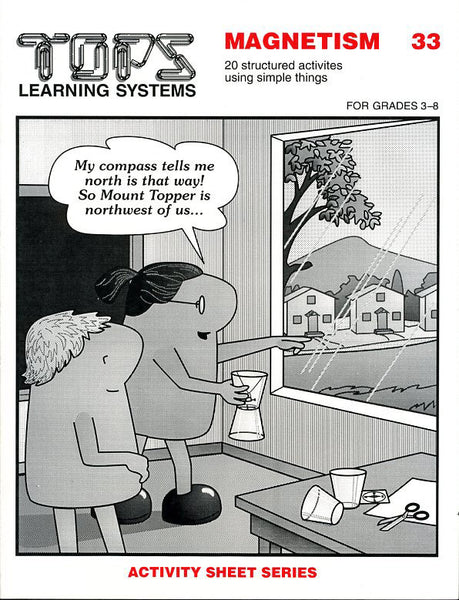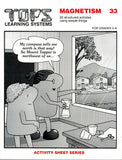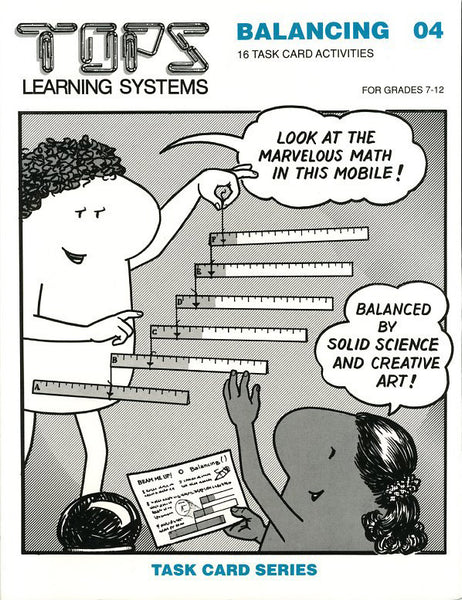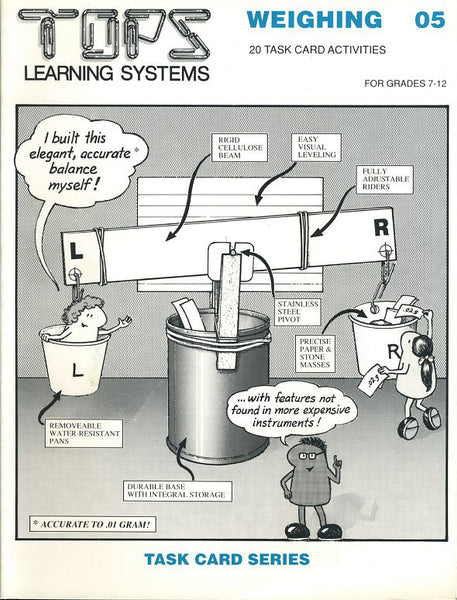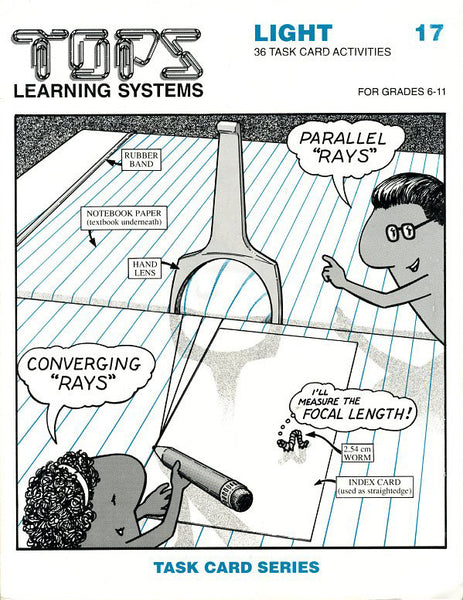#33 Magnetism (grades 3 - 8)
Regular price $23.95
Soft-bound, 64 page book, 20 reproducible activity sheets, full teaching notes.
A most compelling and instructive follow-up to Electricity #32, and every bit as much fun. Students employ simple techniques to discover and map interacting magnetic fields, and to graph the strength of magnetic fields over distance. They build compasses, motors, buzzers, and other ingenious inventions, improvising with refrigerator magnets and cheap, simple stuff. So incredibly little teaches so much! An all-time favorite title with both students and instructors.
Click here for a complete list of materials and convenient shopping.
ceramic magnets, paper clips, straight pins, aluminum foil, pennies, thread, masking tape, clear tape, scissors, hole punch, styrofoam cups, inch index cards, plastic cups, permanent markers, nails, bell wire with soft-plastic, easily-stripped insulation, size-D batteries, washers, clothespins, modeling clay, jars or equivalent, rubber bands, thin bare copper or aluminum wire, about 30 or 32 gauge, manila folders, clothes hangers or rigid, flat rulers, rice grains, staples- Lesson 1: To recognize that only a few metals, like iron and steel, are magnetic, while most other materials and nonmetals are not.
- Lesson 2: To identify and label the north and south poles on unmarked magnets by using Earth's magnetic field as a reference.
- Lesson 3: To experimentally determine the pole orientation of pin magnets.
- Lesson 4: To observe interactions between rotating magnetic fields.
- Lesson 5: To appreciate that a magnetic field can pass through solid objects, as long as they are not magnetic.
- Lesson 6: To graph how the strength of a magnet varies with increased distance from the magnet.
- Lesson 7: To develop a simple interpretive model to explain differences between strong magnets, weak magnets, magnetic materials, and nonmagnetic materials.
- Lesson 8: To build an accurate compass by suspending a magnetized pin from a strand of hair.
- Lesson 9: To practice plotting compass directions with a ruler and magnetic compass.
- Lesson 10: To draw a birds-eye view of the classroom as accurately to scale as possible. To compare compass directions on this map to actual compass directions in the room.
- Lesson 11: To map the shape of a magnetic field that surrounds a magnet.
- Lesson 12: To map the shape of two interacting magnetic fields that attract.
- Lesson 13: To map the shape of two interacting magnetic fields that repel.
- Lesson 14: To learn how to construct and use an electromagnet. To appreciate that electromagnets are temporary, working only when electricity passes through the coil.
- Lesson 15: To build a compass by balancing two magnetized pins upon a third.
- Lesson 16: To build simplified models of an electric motor. To understand how they work.
- Lesson 17: To build a working model of a telegraph. To understand how it functions.
- Lesson 18: To build a working model of a buzzer. To understand how it operates.
- Lesson 19: To build a tiny motor that spins by turning itself on and off. To understand how it works.
- Lesson 20: To enjoy a game of skill using magnets.
Take apart those used electric toothbrush heads and pull out both powerful magnets. Try substituting these in selected experiments for our less powerful ceramic magnets, then tell us how these enhance or possibly change your experimental results. (CAUTION: small magnets are extremely dangerous if swallowed, as two or more can attract each other through intestinal walls. Never leave younger children unsupervised with small magnets.)
As with many TOPS units, these activities give helpful practice in reading and following directions and encourage independent study. Physical results give almost instant feedback, and quick success builds student focus, confidence and enthusiasm. Magnetism is a particularly good subject for students for whom English is not their native language.
Keep a few magnets available in a corner workstation for students who finish tests early, or for constructive activity on rainy days. Consider extra credit for students who construct new physics experiments using magnetism.
NOTE: We encourage improvisation - it's one of the main goals of our hands-on approach! You and your students might invent a simpler, sturdier or more accurate system; might ask a better question; might design a better extension. Hooray for ingenuity! When this occurs, we'd love to hear about it and share it with other educators.
TEACHING Standards
These 20 Activity Sheets promote excellence in science teaching by these NSES criteria:Teachers of science...
A: ...plan an inquiry-based science program. (p. 30)
B: ...guide and facilitate learning. (p. 32)
C: ...engage in ongoing assessment of their teaching and of student learning. (p. 37)
D: ...design and manage learning environments that provide students with the time, space, and resources needed for learning science. (p. 43)
CONTENT Standards
These 20 Activity Sheets contain fundamental content as defined by these NSES guidelines (p. 109).• Represent a central event or phenomenon in the natural world.
• Represent a central scientific idea and organizing principle.
• Have rich explanatory power.
• Guide fruitful investigations.
• Apply to situations and contexts common to everyday experiences.
• Can be linked to meaningful learning experiences.
• Are developmentally appropriate for students at the grade level specified.
Unifying Concepts and Processes
NSES Framework: Systems, order, and organization • Evidence, models and explanation • Constancy, change, and measurement • Evolution and equilibrium • Form and functionCore Concepts/Processes: Like poles repel, unlike poles attract. • North on a compass is attracted to magnetic north because Earth is a giant mislabeled magnet. • A magnetic field has force and direction • The strength of a magnet increases with the degree of alignment of its magnetic domains. • Electromagnetism is a core function underlying many technological forms.
Science as Inquiry (content standard A)
NSES Framework: Identify questions that can be answered through scientific investigations. • Design and conduct a scientific investigation. • Use appropriate tools and techniques to gather, analyze, and interpret data. • Develop descriptions, explanations, predictions, and models using evidence. • Think critically and logically to connect evidence and explanations. • Recognize and analyze alternative explanations and predictions. • Communicate scientific procedures and explanations. • Use mathematics in all aspects of scientific inquiry.Core Inquiries: What does a magnetic field look like? • Graph how its strength changes with distance.
Physical Science (content standard B)
NSES Framework: Light, heat, electricity, and magnetism • Properties and changes of properties in matter • Motions and forces • Transfer of energy
Core Content: Magnetic and nonmagnetic • Magnetic poles • Attraction • Repulsion • Permanent magnets • Induced magnets • Electromagnets • Magnetic force fields • Magnetic domains • Magnetic field strength • Compasses • Motors • Buzzers • Telegraphs
Earth and Space Science (content standard D)
NSES Framework: Properties of earth materials • Structure of the earth system
Core Content: Iron has magnetic properties • Earth is a giant mislabeled magnetic • Scale Drawings • Orienteering
Science and Technology (content standard E)
NSES Framework: Abilities of technological design • Understanding about science and technologyCore Content: Invent gadgets: compasses, electromagnets, telegraphs, buzzers, and motors. Understand how they work.

